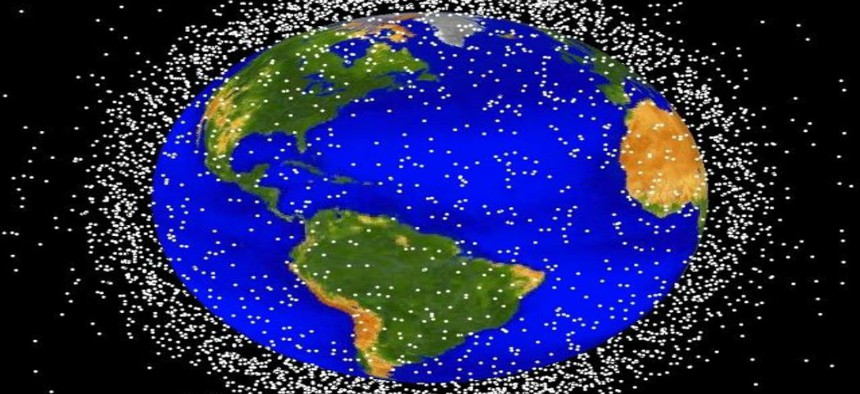Better tracking, resilience needed for milsats
An annual space index emphasizes steps for managing increasingly crowded orbital slots.
The latest edition of an annual space security index emphasizes that it's getting congested up there, that space debris is a growing problem and new space situational awareness tools are needed to detect and track a growing constellation of satellites used for military and commercial purposes—often both.
Along with crowding at prime slots in geosynchronous orbits, the annual index released this week warns that satellites using the same frequencies create greater chances for interference. Among the recent efforts aimed at mitigating satellite interference are secure, laser-based satellite communications development and efforts by the U.S. military to develop common architectures for satellite ground stations.
As low-Earth and geosynchronous orbits grow more congested, the space index also notes a shift toward resilience, redundancy and the ability to quickly reconstitute satellite capabilities. That has prompted efforts to develop smaller, less expensive spacecraft that also would be less tempting targets in a space clash compared to large and expensive intelligence and communications satellites.
As for reconstituting space assets, the index notes that "capabilities to refit space systems by launching new satellites into orbit in a timely manner to replace satellites damaged or destroyed by an attack are critical resilience measures."
Expanding space situational awareness capabilities are also seen as a major step toward space security, the index noted. With that in mind, the Defense Advanced Research Projects Agency last month handed over a space tracking telescope to the Air Force for identifying space junk and satellites. The goal is to reduce the chances of satellite collisions in Earth orbit. Another proposal calls for providing new onboard maneuvering capabilities to help avoid collisions and, in wartime, elude anti-satellite attacks.
While the U.S., China and Russia have demonstrated anti-satellite capabilities, another growing threat is ground-based anti-satellite weapons, including "precision-guided kinetic-intercept vehicles." With an eye toward limiting lethal orbital debris in a space clash, the Air Force also has been testing ground-based lasers that could be used to blind, but not destroy, enemy satellites. The effort is part of a larger Air Force "counterspace" effort.
The space index reckons that "technological barriers remain" in efforts to develop high-energy lasers. Along with "hit-to-kill" technologies, the index notes that Russia has deployed electronic warfare systems in Syria and Ukraine that also could threaten space assets.
The growing view is that the U.S., which has fielded more military intelligence and communications satellite along with navigation constellations, has far more to lose in an anti-satellite clash than Russia or China. Hence, U.S. and Chinese officials have been meeting in an attempt to keep the lines of communications open on military and commercial space activities. The State Department hosted another round of talks in late October, but said only that a third round would be held in China next year.
"China does not maintain a strong separation between civil and military applications, but its program is widely believed to provide support to the military," the authors of the latest space index noted. Meanwhile, a restructuring of the Chinese military along the lines of the U.S. regional command structure is stressing "enhanced access to reconnaissance and position, navigation and timing capabilities."
NEXT STORY: DISA preps $17 billion JIE contract proposal




